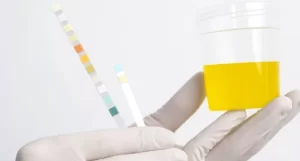What Do Hyaline Casts Found in Urine Indicate?

Hyaline casts represent a basic form of urinary casts. These microscopic structures can be composed of cells, lipids, particulate matter, or microorganisms encased within a protein framework. As tubular formations, they are identifiable via microscopic examination, suggesting potential issues with the kidneys or other health concerns. Even individuals without chronic health conditions may occasionally produce urinary casts as a result of factors like dehydration. The detection of these casts involves a straightforward and non-invasive process of collecting and analyzing urine samples, which is entirely without risks. Cast formation occurs within the Distal convoluted tubule (DCT) and renal ducts due to the accumulation of a protein called uromodulin, secreted by tubule epithelial cells. There are primarily two categories of urinary casts: cellular and non-cellular, with hyaline casts falling into the non-cellular group. This article aims to explore the nature of hyaline casts in the urine, the reasons for their presence, and their acceptable levels.
What are Hyaline casts in urine?
In both healthy individuals and those with renal ailments, hyaline casts can be present. Their appearance is often linked to reduced or slowed urine flow, which may occur after intense physical activity, the use of diuretic therapy, episodes of severe vomiting, or febrile states. An increased presence of hyaline casts could signify renal issues, warranting medical consultation.
What do hyaline casts in urine indicate?
Hyaline casts serve as indicators for renal complications or infections such as pyelonephritis, as well as chronic conditions like kidney impairment due to hypertension and lupus. Additionally, kidney damage resulting from diabetes, known as diabetic nephropathy, can also be detected through the presence of these casts.
The presence of some hyaline casts is regular. These are the most common types of urinary casts. They’re made up of a protein called uromodulin and are usually caused by dehydration, strenuous exercise, and kidney failure.
Abnormal amounts of hyaline casts can indicate problems like Nephrotic syndrome or conditions such as cytomegalovirus (CMV) nephritis and kidney transplant rejection. Your Healthcare provider will tell you more about your results and what they indicate, so it is important to consult them.
What are the causes of hyaline casts in urine?
Hyaline casts in urine can be due to some causes, which are mentioned below:
Dehydration, use of diuretics, or physical exercise are possible reasons for hyaline casts.
Physiological problems can also be a significant cause of hyaline casts.
Slow urinary flow due to kidney diseases can cause a hyaline cast.
Kidney infection can cause hyaline casts.
Congestive heart failure can lead to hyaline casts.
Kidney damage from diabetes (i.e., diabetic nephropathy) can result in hyaline casts.
What is the normal range of hyaline casts in urine?
Hyaline casts are seen under a microscope’s Low power field (LPF). Usually, the presence of casts in the urine is generally considered an unusual finding. However, small amounts of hyaline casts (between 0–2 casts per low power field of the microscope) may be detected in the urine of healthy individuals without necessarily indicating a severe condition like kidney disease. Your doctor will tell you whether you need more tests to detect hyaline casts based on your present status and history.
What is considered a high range of hyaline casts in urine?
As discussed, casts are indicative of possible kidney disease. However, hyaline casts are slightly different and can be seen with any possible kidney disease. If more than 2 hyaline casts/LPF are observed, your healthcare provider will recommend more tests to confirm kidney problems.
Diagnosis of Hyaline Casts in urine?
Hyaline casts are diagnosed by microscopy technique which is a part of a test called urine analysis.
This test is performed by centrifuging a urine sample so that the suspended particles in the urine (e.g. casts, cells, pathogenic microorganisms), also known as urine sediment, are separated from the fluid.
A small urine drop is then placed on a slide made of glass to be examined under the microscope.
Under the microscope, hyaline casts are shown as transparent, tiny particles.
They are easily missed and can’t be seen due to their low refractive index or the lack of contrast between the surrounding urine and the hyaline casts.
Prevention of hyaline casts in urine?
If hyaline casts are detected in patients with kidney damage, treatment may be necessary and will depend on the specific cause of decreased renal function. But few prevention options may involve
Avoiding Diuretic medications
Being hydrated with water and liquids
Addressing the cause of kidney damage early and consult the doctor immediately.
Regular medical checkups help identify underlying medical conditions before the formation of the high number of casts and their excretion in the urine.
Avoiding non-steroidal anti-inflammatory drugs can increase protein concentration, so minimizing it can lead to the prevention of the formation of casts.
What do the different types of urinary casts indicate in a test?
The type of urinary cast found in testing can indicate a condition that can help doctors confirm a diagnosis. Types of casts and the problem they indicate are as follows:
Hyaline casts: Dehydration or chronic kidney disease.
RBC casts: Inflammation of the kidney’s filters (glomerulonephritis)
WBC casts: Kidney inflammation or infection.
Bacterial casts: Infections.
Fatty casts: Too much protein in the urine (nephrotic syndrome), lupus, lipoid nephrosis.
Renal tubular epithelial casts: Damage to kidney tubes.
Granular casts: Urinary retention, urinary tract infections, chronic kidney disease.
Waxy casts: Urinary retention, advanced kidney disease.
Takeaway
Hyaline casts are simple urinary casts generally in the range of 0-2 in a healthy individual. These casts may be caused by doing heavy exercises, kidney infections, and congestive heart failure-like conditions. Simple and painless tests like urinalysis and microscopy diagnose these casts. More than 2 casts in urine can indicate abnormal kidney functions for which the prevention tips must be followed, and consult your doctor for proper treatment.




